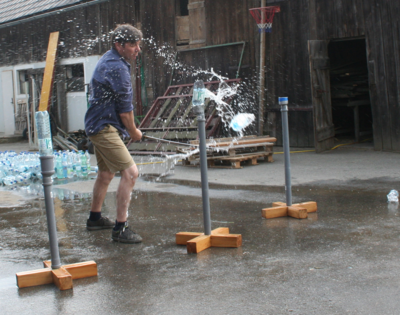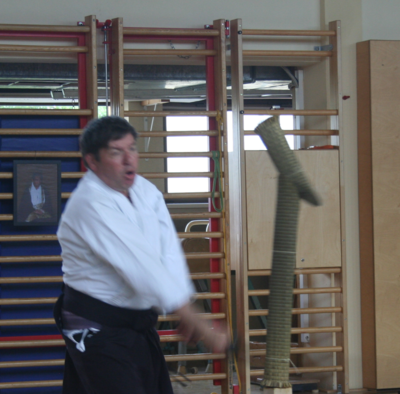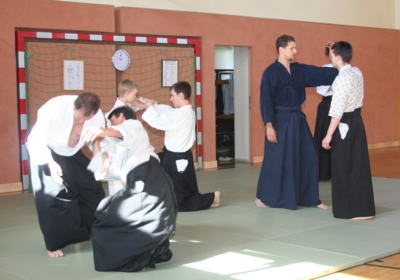A Jigen Ryu Seminar in Austria
In May 2018 I had the opportunity to travel to Austria to train at the Jigen Ryu Gasshuku (summer camp). I've been sporadically corresponding with Robert Reinberger, who heads the jujutsu section, for decades but never before met him so this was an excellent opportunity.
Jigen Ryu, (慈眼流) not to be confused with the koryu Jigen Ryu (示現 流) was founded by Harada sensei when he moved from Suffolk, UK to Austria around 1990. He taught a group there until his death in 2006. In the UK, he and Tanaka Sensei had been teaching jujutsu to a group of us under the Daiwa Ryu label. This gasshuku granted me the opportunity to see how the esoteric jujutsu of Harada sensei had evolved over the years — or how I had diverged from it — as well as a chance to make some new friends.
Dragging myself out of bed in rural Oxfordshire at a stupidly early hour of the morning, I made my flight to Vienna where I was collected by Robert. We then headed off on a two hour drive to the gasshuku venue. During this drive it was highly apparent that Robert is a keen historian of jujutsu; I learnt a great deal and would have learnt still more if not for that 4 a.m. start.
From my perspective the gasshuku had three main prongs: jujutsu, kenjutsu and social. The social side was immediately apparent; this small group, perhaps fifteen or so, enthusiastically welcomed in a stranger who couldn't speak their language and who's attempts at doing so sounded like something out of Allo, Allo. Decades old school boy German, combined with the Austrian dialect, is not a recipe for easy communication. Despite that we had a lot of good conversations on a range of subjects from Jujutsu to Quantum Physics. Quite how the latter arose I am unsure, but beer was involved. The venue, a guest house run by the Krautwurst family on a farm in Ottenschlag, contributed to the communal feel, as did the large quantities of home cooked food, and a self administered bar tab.

The kenjutsu we practised was Eishin Ryu Batto Ho. These techniques, like the Toyama Ryu practised in Warborough, was a twentieth century creation designed to teach basic sword techniques to military personnel in a short period of time. Sufficiently different to Toyama Ryu to be confusing, I none the less managed to get a crude grasp of the first four kata under Robert's vigilant tutelage. As well as the kenjutsu, there were a couple of sessions of tameshigiri, practice cutting.

The first was a fairly lighthearted affair. In the farmyard outside our guesthouse we cut water filled plastic bottles that our hosts had been stockpiling for the previous year. If you were accurate with your blade angle, the bottles cut fairly easily; off a bit and they bounced away, possibly soaking you in the process. The remains were then dutifully gathered and bagged up for recycling.

The second session was somewhat more serious in feel, cutting reed bundles in the dojo. These had more resistance and required better technique. Although I succeeded with my cuts, I was aware that I was concentrating hard and that the reed bundles were neither trying to avoid my cuts nor to attack me back. Thinking back to the intensity of the Hyoho Nitten Ichi Ryu demonstration that Scott and Kieren performed in Warborough a few years ago, I can now begin to understand how that contributes to the ability to maintain that focus under such conditions.

The jujutsu was highly reminiscent of Harada sensei's approach. Lots of emphasis on tiny manipulations to seemingly effortlessly apply a technique. The frustration of trying to get this relaxed approach brought back similar memories from a cold hall at the Shitenoji School in Suffolk. I think the disparity between our two approaches is down to a number of things. I only trained with Harada sensei for a short time, a couple of decades ago. I think at that that stage I was far from ready for some of the subtlety he was striving to show us. I was also training with Tanaka sense whose jujutsu, though still very subtle, placed more emphahsis on some exquisitely painful locks than Harada's. When, very flatteringly, I was asked to teach several slots during the weekend. I chose to demonstrate some of the locks that Tanaka sensei had shown us; starting with the vanilla Hakko Ryu version, then showing the added tweaks.
Being exposed again to Harada sensei's approach has rekindled my interest. Since then we've had a few bemused sessions at the Warborough dojo as a haltingly tried to explain what I was looking for. Many more years of work lie ahead of me I think.
I'd like to thank my hosts, and in particular Robert Reinberger, for a fantastic few days training, great patience with a newcomer to their group and a wonderful welcome.